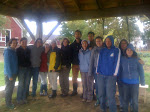 |
| Beautiful Beets |
We spent our morning with Nate learning the steps to crop planning. We started by brainstorming how to look at the whole process of planning--which is essential, since the thinking time in farming is the winter planning. Working on the model of the CSA (Community Supported Agriculture), the big picture is that you are planning how to best use your fields to produce a delightful, consistent delivery to your members. It is such a big thought, Nate recommends categorizing crops. How to categorize crops? By botanical family, by soil needs, by season, by growing time, by culinary necessity, by part of the plant harvested... So much to consider.
 |
| Okra |
So to simplify the process, Mr. Frigard will spend four sessions walking us through his style of planning. We began by categorizing crops into how they are planted: Rapid succession with direct seeding, rapid succession through transplanting, several plantings (either direct seeding or transplanting) and single planting. He then gave each pair of us a set of plants to figure out what style of planting works. My group had beets, bok choi, okra and winter squash. Winter squash is a single planting crop--the plant needs time to develop the long vines and big fruit. Beets are a rapid-succession crop with direct seeding--those seeds pop up some beautiful plants, we harvest them and plant another crop right away. Bok Choi is also a rapid succession crop, best raised with transplants to the field. Okra, not necessarily a New England crop, would do well with several plantings.
 |
| Bok choy or Pac Choi |
We practiced our "CSA thinking" by deciding how many weeks to offer each of these vegetables in the delivery to our hypothetical customers, how many pounds would be needed during the season and we noted anything particular about this crop--is it a standard crop, something special, easy to grow, difficult grow. Once we figured out how many pounds we would need for each season, we needed to calculate a little planting buffer--from 10% to 20% extra pounds to leave room for disease, infestation or poor weather. Once that was calculated, We figured how how many pounds of crop per foot which gave us an idea of how much field space was needed for each crop.
 |
| Winter squash |
Here's an example of the work. If we wanted to offer our 150 CSA members an average of five pounds of winter squash for five weeks at the end of the season, we would need 3750 pounds of squash for the season. We'd put in a 10% buffer making our aim for a yield of 4125 pounds. Squash tends to produce 2 pounds per food. So we would need to put in 2062 feet of squash plantings. More to come in future.
In the afternoon, our group went back outside to work on our barn door project. We were thwarted at several steps along the way, yet made progress and made it beautifully. You cannot tell from this photo the placement of the windows, but trust me, it will be a unique set of doors!
 |
| Nora and Sophia planning out the windows |
 |
| Cutting the windows |
 |
| Emma, Brian and Kiyoshi trimming the second door |








Stay safe in this snowstorm.
ReplyDeleteOOh, we will! We have big plans for the day! Working on the timber frame in the greenhouse AND some sledding.
ReplyDelete